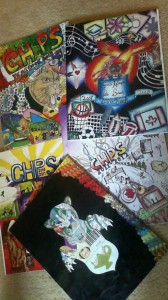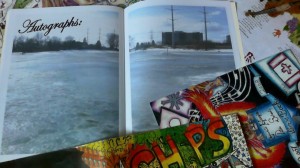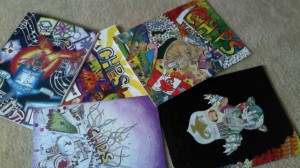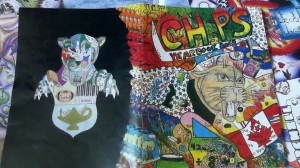


Voted most likely to succeed…
A highly subjective guide to creating yearbooks
Making a yearbook is a rewarding experience for students and teachers. In spring, when the yearbooks come out, our school is a frenzy of autographing, sharing, laughing and remembering. More than a keepsake, yearbook is a process that teaches kids to collaborate on a project much bigger than themselves. It is gratifying to watch them mature into their new roles, and receive accolades for their achievement.
This short series of articles will explain how to set up a Yearbook Club in your elementary or junior high school, and produce an attractive, affordable publication. High schools produce longer, flashier, hard cover books for their graduates. Although I was copy-editor for my high school yearbook, only some of what is discussed here will apply at that level.
The goal of this series is to help elementary and junior high school teachers run an efficient club, whereby students can produce their own inexpensive softcover yearbooks. Future articles will include instructions for using Word, Scrivener, Smashwords, and local print shops to make eBook anthologies, poetry chapbooks and recipe books, but first let’s talk yearbooks.
It is possible to delegate making school yearbooks to a service. Online you will find templates made by various companies looking for your business. These services are probably fine, but before committing to their templates and timelines, consider what you want to achieve. Do you just want to make a keepsake for students and parents, or can yearbook represent a more meaningful learning experience? In our school, originality, student engagement and maintaining an accessible purchase price, are important considerations. Student photos, copy, artwork and layout make for a cheaper and more meaningful final product.
Based on several years of experience, this series of short articles describes one efficient and inexpensive method for creating attractive yearbooks. Expertise isn’t necessary. Making a yearbook doesn’t need to be difficult or excessively time consuming. The most important aspects are planning and delegation, since the technical aspects are fairly simple.
Using Publisher, it is possible to create a standard template for the yearbook which your team can use to design all their layouts. Once these are done, publication is as easy as taking the file to your local copy shop on a flash drive. The printer takes these ready-to-go files and prints your book, complete with glossy cover, in about a week. Here are some of the steps to setting up your Yearbook Club.
“When casting’s done, 90 percent of my creative work is done” — film director Robert Altman
If directing is ninety per cent casting, the same can be said of producing a school yearbook. The most essential part is assembling the right team. This is no place for half-interested students. I run yearbook more like a sports team. Would-be participants try out, or at least demonstrate dedication, before earning the right to be ‘starters.’
Making your club small and selective has many benefits.
- Students specialize and take on responsibilities within one of several small (and therefore efficient) teams. I try to limit size to three people for quick decision making
- Students who have chosen their roles (rather than having them assigned) are more invested in the final results, and more motivated to work long hours (as needed) when deadlines approach
- Assigning two editors to the overall book takes some time pressure off teacher supervisors
- There needs to be a layout editor and a content editor if your school intends to include articles, or just two main editors so they can help each other. Two are better than one for collaboration, and also in case one gets sick or overwhelmed by academic deadlines
- Having three teacher supervisors (not just one) allows them to spell each other off, and further emphasizes to students that this project is theirs to accomplish. The teachers are just there for supervision and consultation.
- Two student photographers, responsible for covering school events, give more reliable coverage than a changing handful. Make sure they ‘audition’ for the role by showing you/ the editors their work
- A couple of photographers will also get enough practice to improve over the year. Help them use the way their photos appear in layouts as feedback. In a short time, you will see more close-ups, better clarity, better composition, and more expressions of emotion in their images, because the layout team will choose good photos over mediocre ones
- Another tack is to crowd-source photos. At times when there are holes in event coverage, requesting pictures from the student body can work, particularly for events like trips and track meets if student photographers are not allowed to attend
- The photographers should either have their own cameras, or instant access to school cameras to ensure they don’t miss unplanned photo opportunities
- Holding meetings over the lunch hour works for us. We use tri-weekly meetings to update progress and hand out assignments, but much of the actual writing, layout and photographing is done by students on their own time
- For the fastest, easiest yearbook, include less text
- Text is one of the most creative aspects of a yearbook, but it requires hours of teacher editing for content, as well as prose style. Decide early on your priorities and remember, some students will try to get something funny past you! Never let a single unedited word get published. The same goes for photos.
- To involve the greater school community, hold a contest for best cover design. Make sure your contest publicity outlines requirements for the cover such as: title, school name, year, size of image, use of colour etc.
- If there are two great covers to choose from, or if one cover has great art but insufficient text, the second design may make a great back cover
- Offering a free copy of the yearbook to the winners is an inexpensive incentive to encourage more quality designs
- Reserve the right to use a photographic cover if insufficient entries are received (Our school has never had to do this.)
I hope you found these tips helpful. Before getting started on a project which can grow in difficulty and complexity with ambition, it’s important to set parameters. Next time we will talk about layout, planning, and keeping things practical.
